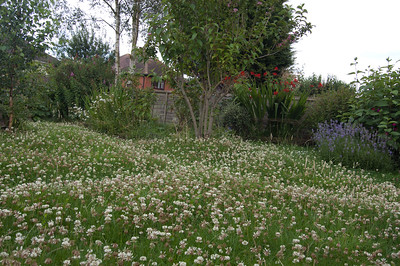
THE MEN WHO DITCHED THEIR GRASS LAWNS FOR CLOVER
Traditional grass lawns originated as a status symbol, but clover lawns are becoming the go-to choice for a cheap, climate-friendly yard that’s easy to maintain
For years, having a two-story house with a mid-size SUV on the driveway and a lush, perfectly manicured lawn was the vision of success that kept Mark, 37, happy in his northern Virginia neighborhood. Around 2019, however, he sensed the slow creep of death and decay surrounding him. “Almost every yard in the neighborhood was either completely dead, on the verge of dying or put on life support via sprinklers running almost 24 hours a day,” he says. “And mine was well on its way to suffering the same fate.”
Mark began scouring the internet for alternative lawns that required less water and discovered r/NoLawns, a Reddit community dedicated to going lawn-free. There, he found many people like Dave posting photos of their clover lawns, or yards composed mostly, if not exclusively, of clovers.
“I’d rather not spread chemicals to kill other plants and spread fertilizer just to have a yard that requires extra watering while we’re in a drought,” says Dave, a 54-year-old in Raleigh, North Carolina. “Clover is certainly less expensive than a fescue grass yard, it grows like a weed, it’s really low maintenance and it’s exceptionally good for the environment to boot.”
Not only does clover involve less watering, but it also creates its own fertilizer, provides pollen for native insects, “out-competes” other weeds and grows low, which equates to less mowing. “It’s sustainable and as close to needing no maintenance as I’ve found,” says Dave. “And I’m all about less effort.”
RECOMMENDED READING
- CULTURE: A Highly Questionable Cultural History of Richard Gere’s Ass Gerbil
- CULTURE: Why Did We Grow Up Thinking a Piercing in the Right Ear Was Gay?
- CULTURE: What Activists Are Doing to Fight the Rampant Growth of Bestiality
- CULTURE: ‘2 Girls 1 Cup’: An Investigation Into the Web’s Shittiest Mystery
That said, he adds that anyone looking to convert their lawns to clover should know a few things first. “There are many clover varieties, some for shade, most for full sun,” he explains. “Mix and match for a nice low-maintenance yard — if your homeowner association permits it like mine does.”
Dave says he used “white clover for full sun, subterranean clover for the shady spots, mowed my lawn with the mower set to ‘scalp,’ then broadcast-spread the clover seeds and watered every day for two weeks.” After that, he just “let it grow.”
“Clovers grow like a weed, I never water or fertilize and I mow it about every two to three weeks in the summer on the long-cut setting to keep it clean-looking,” Mark adds. “At the end of the season I let it bloom and it reseeds itself — what’s not to like?”
To be sure, there is at least one thing not to like. Because the increased amount of pollen in clovers attracts bees, some argue that clover lawns aren’t great for “high traffic” areas. If nothing else, a neatly cut grass lawn is a safe place for barefoot kids to run around without fear of being stung. However, neither Mark nor Dave are bothered by the extra bees hanging around. “If someone stepped on you, you’d be upset too,” Dave tells me. “A clover yard is certainly worth the risk.”
“My kid got stung once on his foot, but he’s had much more fun exploring and finding all the other bugs in the yard,” Mark adds. “We’ve got more lightning bugs in our yard than anyone else, which more than makes up for it.”
Either way, he’s never turning back. “It’s funny, I used to break my back meticulously picking clovers out of my lawn,” Mark says. “But now I’m never bothering with a grass lawn again, and convincing my neighbors to do the same.”
